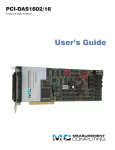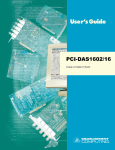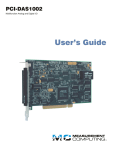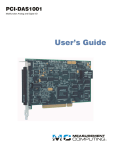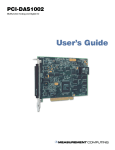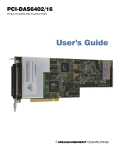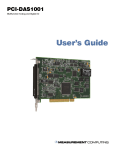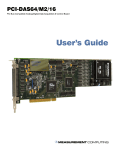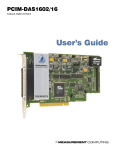Download MC PCI-DAS1602 User`s guide
Transcript
PCI-DAS1602/12 Analog and Digital I/O Board User's Guide Document Revision 7, March, 2009 © Copyright 2009, Measurement Computing Corporation Your new Measurement Computing product comes with a fantastic extra — Management committed to your satisfaction! Thank you for choosing a Measurement Computing product—and congratulations! You own the finest, and you can now enjoy the protection of the most comprehensive warranties and unmatched phone tech support. It’s the embodiment of our mission: To provide PC-based data acquisition hardware and software that will save time and save money. Simple installations minimize the time between setting up your system and actually making measurements. We offer quick and simple access to outstanding live FREE technical support to help integrate MCC products into a DAQ system. Limited Lifetime Warranty: Most MCC products are covered by a limited lifetime warranty against defects in materials or workmanship for the life of the product, to the original purchaser, unless otherwise noted. Any products found to be defective in material or workmanship will be repaired, replaced with same or similar device, or refunded at MCC’s discretion. For specific information, please refer to the terms and conditions of sale. Harsh Environment Program: Any Measurement Computing product that is damaged due to misuse, or any reason, may be eligible for replacement with the same or similar device for 50% of the current list price. I/O boards face some harsh environments, some harsher than the boards are designed to withstand. Contact MCC to determine your product’s eligibility for this program. 30 Day Money-Back Guarantee: Any Measurement Computing Corporation product may be returned within 30 days of purchase for a full refund of the price paid for the product being returned. If you are not satisfied, or chose the wrong product by mistake, you do not have to keep it. These warranties are in lieu of all other warranties, expressed or implied, including any implied warranty of merchantability or fitness for a particular application. The remedies provided herein are the buyer’s sole and exclusive remedies. Neither Measurement Computing Corporation, nor its employees shall be liable for any direct or indirect, special, incidental or consequential damage arising from the use of its products, even if Measurement Computing Corporation has been notified in advance of the possibility of such damages. HM PCI-DAS1602_12.doc 2 PCI-DAS1602/12 User's Guide Trademark and Copyright Information TracerDAQ, Universal Library, Measurement Computing Corporation, and the Measurement Computing logo are either trademarks or registered trademarks of Measurement Computing Corporation. Windows, Microsoft, and Visual Studio are either trademarks or registered trademarks of Microsoft Corporation LabVIEW is a trademark of National Instruments. CompactFlash is a registered trademark of SanDisk Corporation. XBee and XBee-PRO are trademarks of MaxStream, Inc. All other trademarks are the property of their respective owners. Information furnished by Measurement Computing Corporation is believed to be accurate and reliable. However, no responsibility is assumed by Measurement Computing Corporation neither for its use; nor for any infringements of patents or other rights of third parties, which may result from its use. No license is granted by implication or otherwise under any patent or copyrights of Measurement Computing Corporation. All rights reserved. No part of this publication may be reproduced, stored in a retrieval system, or transmitted, in any form by any means, electronic, mechanical, by photocopying, recording, or otherwise without the prior written permission of Measurement Computing Corporation. Notice Measurement Computing Corporation does not authorize any Measurement Computing Corporation product for use in life support systems and/or devices without prior written consent from Measurement Computing Corporation. Life support devices/systems are devices or systems which, a) are intended for surgical implantation into the body, or b) support or sustain life and whose failure to perform can be reasonably expected to result in injury. Measurement Computing Corporation products are not designed with the components required, and are not subject to the testing required to ensure a level of reliability suitable for the treatment and diagnosis of people. 3 Table of Contents Preface About This User's Guide ......................................................................................................................6 What you will learn from this user's guide ......................................................................................................... 6 Conventions in this user's guide ......................................................................................................................... 6 Where to find more information ......................................................................................................................... 6 Register-level programming ............................................................................................................................... 7 Chapter 1 Introducing the PCI-DAS1602/12 .........................................................................................................8 Overview: PCI-DAS1602/12 board features ...................................................................................................... 8 Software features ................................................................................................................................................ 8 Chapter 2 Installing the PCI-DAS1602/12 .............................................................................................................9 What comes with your PCI-DAS1602/12 shipment? ......................................................................................... 9 Hardware .......................................................................................................................................................................... 9 Additional documentation ................................................................................................................................................. 9 Optional components .......................................................................................................................................... 9 Unpacking the PCI-DAS1602/12 ..................................................................................................................... 10 Installing the software ...................................................................................................................................... 10 Installing the PCI-DAS1602/12 ....................................................................................................................... 10 Configuring the PCI-DAS1602/12 ................................................................................................................... 11 Connecting the board for I/O operations .......................................................................................................... 11 Connectors, cables – main I/O connector ........................................................................................................................11 Pinout – main I/O connector ............................................................................................................................................12 Cabling.............................................................................................................................................................................13 Field wiring and signal termination .................................................................................................................................14 Chapter 3 Functional Details ...............................................................................................................................16 PCI-DAS1602/12 block diagram ..................................................................................................................... 16 Analog inputs ................................................................................................................................................... 17 Burst mode .......................................................................................................................................................................17 Analog outputs .................................................................................................................................................................18 Parallel digital I/O............................................................................................................................................................18 Counter/timer I/O.............................................................................................................................................................18 Chapter 4 Calibrating the PCI-DAS1602/12 ........................................................................................................19 Analog output calibration ................................................................................................................................. 20 Chapter 5 Specifications ......................................................................................................................................21 Analog input ..................................................................................................................................................... 21 Accuracy ..........................................................................................................................................................................22 Noise performance ...........................................................................................................................................................23 Analog output ................................................................................................................................................... 23 Accuracy ..........................................................................................................................................................................23 Analog output pacing and triggering ...............................................................................................................................24 Digital input/output .......................................................................................................................................... 24 Interrupts .......................................................................................................................................................... 25 Counters............................................................................................................................................................ 25 4 PCI-DAS1602/12 User's Guide Power consumption .......................................................................................................................................... 26 Environmental .................................................................................................................................................. 26 Mechanical ....................................................................................................................................................... 26 Main connector and pin out .............................................................................................................................. 26 Declaration of Conformity ..................................................................................................................29 5 Preface About This User's Guide What you will learn from this user's guide This user's guide explains how to install, configure, and use the PCI-DAS1602/12 so that you get the most out of its get the most out of its analog, digital, and timing I/O features. This user's guide also refers you to related documents available on our web site, and to technical support resources. Conventions in this user's guide For more information on … Text presented in a box signifies additional information and helpful hints related to the subject matter you are reading. Caution! Shaded caution statements present information to help you avoid injuring yourself and others, damaging your hardware, or losing your data. < : > Angle brackets that enclose numbers separated by a colon signify a range of numbers, such as those assigned to registers, bit settings, etc. bold text Bold text is used for the names of objects on the screen, such as buttons, text boxes, and check boxes. For example: 1. Insert the disk or CD and click the OK button. italic text Italic text is used for the names of manuals and help topic titles, and to emphasize a word or phrase. For example: The InstaCal installation procedure is explained in the Quick Start Guide. Never touch the exposed pins or circuit connections on the board. Where to find more information The following electronic documents provide helpful information relevant to the operation of the PCIDAS1602/12. MCC's Specifications: PCI-DAS1602/12 (the PDF version of the Specifications chapter in this guide) is available on our web site at www.mccdaq.com/pdfs/Specs/PCI-DAS1602-12-spec.pdf. MCC's Quick Start Guide is available on our web site at www.mccdaq.com/PDFmanuals/DAQ-Software-Quick-Start.pdf. MCC's Guide to Signal Connections is available on our web site at www.mccdaq.com/signals/signals.pdf. MCC's Universal Library User's Guide is available on our web site at www.mccdaq.com/PDFmanuals/sm-ul-user-guide.pdf. MCC's Universal Library Function Reference is available on our web site at www.mccdaq.com/PDFmanuals/sm-ul-functions.pdf. MCC's Universal Library for LabVIEW™ User’s Guide is available on our web site at www.mccdaq.com/PDFmanuals/SM-UL-LabVIEW.pdf. PCI-DAS1602/12 User's Guide (this document) is also available on our web site at www.mccdaq.com/PDFmanuals/PCI-DAS1602-12.pdf. 6 PCI-DAS1602/12 User's Guide About This User's Guide Register-level programming You should use the Universal Library to control your board. Only experienced programmers should try registerlevel programming. If you need to program at the register level in your application, you can find more information in the Register Map for the PCI-DAS1602/12 (available at www.mccdaq.com/registermaps/RegMapPCI-DAS1602-12.pdf). 7 Chapter 1 Introducing the PCI-DAS1602/12 Overview: PCI-DAS1602/12 board features The PCI-DAS1602/12 multifunction analog and digital I/O board sets a new standard for high performance data acquisition on the PCI bus. This manual explains how to install and use your PCI-DAS1602/12 data acquisition board. The PCI-DAS1602/12 is a multifunction measurement and control board designed for the PCI bus. This board can be used for applications such as data acquisition, system timing, and industrial process control. The PCI-DAS1602/12 board is completely plug and play, with no switches, jumpers or potentiometers to set. All board addresses and interrupt sources are set with software. You calibrate the board with software that uses programmable on-board digital potentiometers and trim D/A converters. The PCI-DAS1602/12 provides the following features: Eight differential inputs or 16 single-ended 12-bit analog inputs Sample rates of up to 330 kHz 24 bits of digital I/O Three 16-bit down-counters 100-pin high density I/O connector Two FIFO-buffered 12-bit analog outputs with update rates of up to 250 kHz Analog input ranges are selectable via software as bipolar or unipolar. Bipolar input ranges are ±10 V, ±5 V, ±2.5 V, and ±1.25 V. Unipolar input ranges are 0 to 10 V, 0 to 5 V, 0 to 2.5 V, and 0 to 1.25 V. The PCIDAS1602/12 board has an analog trigger input. The trigger level and direction are software configurable. The PCI-DAS1602/12 board has two 82C54 counter chips. Each chip contains three 16-bit down counters that provide clock, gate, and output connections. Software features For information on the features of InstaCal and the other software included with your PCI-DAS1602/12, refer to the Quick Start Guide that shipped with your device. The Quick Start Guide is also available in PDF at www.mccdaq.com/PDFmanuals/DAQ-Software-Quick-Start.pdf. Check www.mccdaq.com/download.htm for the latest software version or versions of the software supported under less commonly used operating systems. 8 Chapter 2 Installing the PCI-DAS1602/12 What comes with your PCI-DAS1602/12 shipment? The following items are shipped with the PCI-DAS1602/12. Hardware PCI-DAS1602/12 Additional documentation In addition to this hardware user's guide, you should also receive the Quick Start Guide (available in PDF at www.mccdaq.com/PDFmanuals/DAQ-Software-Quick-Start.pdf). This booklet supplies a brief description of the software you received with your PCI-DAS1602/12 and information regarding installation of that software. Please read this booklet completely before installing any software or hardware.. Optional components If you ordered any of the following products with your board, they should be included with your shipment.. Cables C100FF-x 9 PCI-DAS1602/12 User's Guide Installing the PCI-DAS1602/12 Signal termination and conditioning accessories MCC provides signal conditioning and termination products for use with the PCI-DAS1602/12. Refer to Field wiring and signal termination on page 15 for a complete list of compatible accessory products. Unpacking the PCI-DAS1602/12 As with any electronic device, you should take care while handling to avoid damage from static electricity. Before removing the PCI-DAS1602/12 from its packaging, ground yourself using a wrist strap or by simply touching the computer chassis or other grounded object to eliminate any stored static charge. If any components are missing or damaged, notify Measurement Computing Corporation immediately by phone, fax, or e-mail: Phone: 508-946-5100 and follow the instructions for reaching Tech Support. Fax: 508-946-9500 to the attention of Tech Support Email: [email protected] Installing the software Refer to the Quick Start Guide for instructions on installing the software on the Measurement Computing Data Acquisition Software CD. This booklet is available in PDF at www.mccdaq.com/PDFmanuals/DAQ-SoftwareQuick-Start.pdf. Installing the PCI-DAS1602/12 The PCI-DAS1602/12 board is completely plug-and-play, with no switches or jumpers to set. Configuration is controlled by your system's BIOS. To install your board, follow the steps below. Install the MCC DAQ software before you install your board The driver needed to run your board is installed with the MCC DAQ software. Therefore, you need to install the MCC DAQ software before you install your board. Refer to the Quick Start Guide for instructions on installing the software. 1. Turn your computer off, open it up, and insert your board into an available PCI slot. 2. Close your computer and turn it on. If you are using an operating system with support for plug-and-play (such as Windows 2000 or Windows XP), a dialog box opens as the system loads, indicating that new hardware has been detected. If the information file for this board is not already loaded onto your PC, you are prompted for the disk containing this file. The Measurement Computing Data Acquisition Software CD supplied with your board contains this file. If required, insert the disk or CD and click OK. 3. To test your installation and configure your board, run the InstaCal utility installed in the previous section. Refer to the Quick Start Guide that came with your board for information on how to initially set up and load InstaCal. If your board has been powered-off for more than 10 minutes, allow your computer to warm up for at least 15 minutes before acquiring data with this board. This warm-up period is required in order for the board to achieve its rated accuracy. The high speed components used on the board generate heat, and it takes this amount of time for a board to reach steady state if it has been powered off for a significant amount of time 10 PCI-DAS1602/12 User's Guide Installing the PCI-DAS1602/12 Configuring the PCI-DAS1602/12 All hardware configuration options on the PCI-DAS1602/12 are software controlled. You can select some of the configuration options using InstaCal, such as the analog input configuration (16 single-ended or eight differential channels), the edge used for triggering when using an external pacer, and the counter source. Once selected, any program that uses the Universal Library initializes the hardware according to these selections. Connecting the board for I/O operations Connectors, cables – main I/O connector The table below lists the board connectors, applicable cables, and compatible accessory products for the PCIDAS1602/12. Board connector, cables, and accessory equipment Connector type Compatible cables Compatible accessory products with the C100FF-x cable 100-pin high-density Robinson-Nugent C100FF-x ISO-RACK16/P SCB-50 ISO-DA02/P SSR-RACK24 (DADP-5037 adaptor required) BNC-16SE SSR-RACK08 (DADP-5037 with TN-MC78M05CT adaptor required) BNC-16DI CIO-ERB24 (DADP-5037 adaptor required) CIO-MINI50 CIO-ERB08 (DADP-5037 adaptor required) CIO-TERM100 CIO-SERB08 (DADP-5037 adaptor required) The PCI-DAS1602/12 board's main I/O connector is a 100-pin high density connector labeled J1. All signals pass through this connector. The pinout for eight-channel differential mode is listed on page 12. The pinout for 16-channel single ended mode is listed on page 13. Information on signal connections General information regarding signal connection and configuration is available in the Guide to Signal Connections (available at www.mccdaq.com/signals/signals.pdf). Caution! When connecting a cable to the board's I/O connector, make sure that the arrow indicating pin 1 on the board connector lines up with the arrow indicating pin 1 on the cable connector. Connecting cables can damage the board and the I/O controller. 11 PCI-DAS1602/12 User's Guide Installing the PCI-DAS1602/12 Pinout – main I/O connector 8-channel differential mode pin out Signal Name GND EXTERNAL INTERRUPT n/c EXTERNAL D/A PACER GATE D/A INTERNAL PACER OUTPUT A/D INTERNAL PACER OUTPUT n/c n/c -12 V GND +12 V GND n/c n/c n/c n/c n/c n/c n/c n/c n/c n/c n/c n/c n/c n/c FIRSTPORTC Bit 7 FIRSTPORTC Bit 6 FIRSTPORTC Bit 5 FIRSTPORTC Bit 4 FIRSTPORTC Bit 3 FIRSTPORTC Bit 2 FIRSTPORTC Bit 1 FIRSTPORTC Bit 0 FIRSTPORTB Bit 7 FIRSTPORTB Bit 6 FIRSTPORTB Bit 5 FIRSTPORTB Bit 4 FIRSTPORTB Bit 3 FIRSTPORTB Bit 2 FIRSTPORTB Bit 1 FIRSTPORTB Bit 0 FIRSTPORTA Bit 7 FIRSTPORTA Bit 6 FIRSTPORTA Bit 5 FIRSTPORTA Bit 4 FIRSTPORTA Bit 3 FIRSTPORTA Bit 2 FIRSTPORTA Bit 1 FIRSTPORTA Bit 0 Pin 100 99 98 97 96 95 94 93 92 91 90 89 88 87 86 85 84 83 82 81 80 79 78 77 76 75 74 73 72 71 70 69 68 67 66 65 64 63 62 61 60 59 58 57 56 55 54 53 52 51 PCI slot ■ ■ ■ ■ ■ ■ ■ ■ ■ ■ ■ ■ ■ ■ ■ ■ ■ ■ ■ ■ ■ ■ ■ ■ ■ ■ ■ ■ ■ ■ ■ ■ ■ ■ ■ ■ ■ ■ ■ ■ ■ ■ ■ ■ ■ ■ ■ ■ ■ ■ ↓ 12 ■ ■ ■ ■ ■ ■ ■ ■ ■ ■ ■ ■ ■ ■ ■ ■ ■ ■ ■ ■ ■ ■ ■ ■ ■ ■ ■ ■ ■ ■ ■ ■ ■ ■ ■ ■ ■ ■ ■ ■ ■ ■ ■ ■ ■ ■ ■ ■ ■ ■ Pin 50 49 48 47 46 45 44 43 42 41 40 39 38 37 36 35 34 33 32 31 30 29 28 27 26 25 24 23 22 21 20 19 18 17 16 15 14 13 12 11 10 9 8 7 6 5 4 3 2 1 Signal Name GND SSH OUT PC +5 V n/c n/c A/D EXTERNAL TRIGGER IN D/A EXTERNAL PACER IN ANALOG TRIGGER IN A/D EXTERNAL PACER CTR 4 OUT CTR 4 GATE CTR 4 CLK D/A OUT 1 D/A GND 1 D/A OUT 0 D/A GND 0 n/c n/c n/c n/c n/c n/c n/c n/c n/c n/c n/c n/c n/c n/c n/c n/c LLGND CH7 LO CH7 HI CH6 LO CH6 HI CH5 LO CH5 HI CH4 LO CH4 HI CH3 LO CH3 HI CH2 LO CH2 HI CH1 LO CH1 HI CH0 LO CH0 HI LLGND PCI-DAS1602/12 User's Guide Installing the PCI-DAS1602/12 16-channel single-ended mode pin out Signal Name GND EXTERNAL INTERRUPT n/c EXTERNAL D/A PACER GATE D/A INTERNAL PACER OUTPUT A/D INTERNAL PACER OUTPUT n/c n/c -12 V GND +12 V GND n/c n/c n/c n/c n/c n/c n/c n/c n/c n/c n/c n/c n/c n/c FIRSTPORTC Bit 7 FIRSTPORTC Bit 6 FIRSTPORTC Bit 5 FIRSTPORTC Bit 4 FIRSTPORTC Bit 3 FIRSTPORTC Bit 2 FIRSTPORTC Bit 1 FIRSTPORTC Bit 0 FIRSTPORTB Bit 7 FIRSTPORTB Bit 6 FIRSTPORTB Bit 5 FIRSTPORTB Bit 4 FIRSTPORTB Bit 3 FIRSTPORTB Bit 2 FIRSTPORTB Bit 1 FIRSTPORTB Bit 0 FIRSTPORTA Bit 7 FIRSTPORTA Bit 6 FIRSTPORTA Bit 5 FIRSTPORTA Bit 4 FIRSTPORTA Bit 3 FIRSTPORTA Bit 2 FIRSTPORTA Bit 1 FIRSTPORTA Bit 0 Pin 100 99 98 97 96 95 94 93 92 91 90 89 88 87 86 85 84 83 82 81 80 79 78 77 76 75 74 73 72 71 70 69 68 67 66 65 64 63 62 61 60 59 58 57 56 55 54 53 52 51 PCI slot ■ ■ ■ ■ ■ ■ ■ ■ ■ ■ ■ ■ ■ ■ ■ ■ ■ ■ ■ ■ ■ ■ ■ ■ ■ ■ ■ ■ ■ ■ ■ ■ ■ ■ ■ ■ ■ ■ ■ ■ ■ ■ ■ ■ ■ ■ ■ ■ ■ ■ ■ ■ ■ ■ ■ ■ ■ ■ ■ ■ ■ ■ ■ ■ ■ ■ ■ ■ ■ ■ ■ ■ ■ ■ ■ ■ ■ ■ ■ ■ ■ ■ ■ ■ ■ ■ ■ ■ ■ ■ ■ ■ ■ ■ ■ ■ ■ ■ ■ ■ Pin 50 49 48 47 46 45 44 43 42 41 40 39 38 37 36 35 34 33 32 31 30 29 28 27 26 25 24 23 22 21 20 19 18 17 16 15 14 13 12 11 10 9 8 7 6 5 4 3 2 1 Signal Name GND SSH OUT PC +5 V n/c n/c A/D EXTERNAL TRIGGER IN D/A EXTERNAL PACER IN ANALOG TRIGGER IN A/D EXTERNAL PACER CTR 4 OUT CTR 4 GATE CTR 4 CLK D/A OUT 1 D/A GND 1 D/A OUT 0 D/A GND 0 n/c n/c n/c n/c n/c n/c n/c n/c n/c n/c n/c n/c n/c n/c n/c n/c LLGND CH15 HI CH7 HI CH14 HI CH6 HI CH13 HI CH5 HI CH12 HI CH4 HI CH11 HI CH3 HI CH10 HI CH2 HI CH9 HI CH1 HI CH8 HI CH0 HI LLGND ↓ The signal names for pins 2 to 17 define the functions for both single-ended modes and also for differential input modes. For example, if you are using eight differential inputs, pin 2 is the high side of channel 0 (CH0 HI) and pin 3 is the low side (CH0 LO) of channel 0. If you are using single-ended inputs, pin 2 is channel 0 (CH0 HI), but pin 3 is now channel 8 (CH8 HI). When you use single-ended inputs, use LLGND (and not GND) for analog signal returns. Cabling You can use a C100FF-x cable to connect signals to the PCI-DAS1602/12 board. The C100FF-x cable is made up of two 50-pin ribbon cables that are joined at one end with a 100-pin connector. The two 50-pin cables diverge and are terminated at the other end with standard 50-pin header connectors. 13 PCI-DAS1602/12 User's Guide Installing the PCI-DAS1602/12 Cable is labeled “Pins 1-50” 49 50 1 2 Key 50 100 The red stripe identifies pin # 1 99 100 Field Wiring connections: SCB-50 CIO-MINI50 CIO-MINI50/DST CIO-TERM100/DST BNC-16DI or BNC-16SE ISO-RACK16/P or ISO-DA02/P with the DADP-5037 adaptor board: CIO-ERB08 or CIO-ERB24 SSR-RACK08 or SSR-RACK24 1 51 Key Connect to the board’s 100-pin I/O connector. Pin 1 is indicated by an arrow on the connector. 51 52 Cable is labeled “Pins 51-100” The red stripe identifies pin # 51 Figure 1. C100FF-x cable The first 50-pin connector is used primarily for analog signals (pins 1-50 of the 100-pin connector). The second 50-pin connector is used primarily for digital I/O signals (pins 51-100 of the 100-pin connector). This configuration minimizes noise in the analog signal lines, and greatly simplifies field wiring and connections to external devices. You can purchase C100FF-x series cables from our web site at www.mccdaq.com/products/accessories.aspx. Field wiring and signal termination You can use the following MCC screw terminal boards to terminate field signals and route them into the PCIDAS1602/12 board using the C100FF-x cable: Screw terminal boards CIO-TERM100 – 100 pin, 16 x 4 screw terminal board. CIO-MINI50 – 50-pin universal screw terminal accessory. Two boards are required. SCB-50 – 50-conductor, shielded signal connection/screw terminal box providing two independent 50-pin connections. One box is required. Details on these products are available at www.mccdaq.com/products/screw_terminal_bnc.aspx. BNC connector interface boxes BNC-16SE – 16-channel single-ended BNC connector box. BNC-16DI – Eight-channel differential BNC connector box. Details on these products are available at www.mccdaq.com/products/screw_terminal_bnc.aspx. 14 PCI-DAS1602/12 User's Guide Installing the PCI-DAS1602/12 Analog signal conditioning and expansion ISO-RACK16/P – 16-channel isolation module mounting rack. ISO-DA02/P – Two-channel, 5B module rack. Details on these products are available at www.mccdaq.com/products/signal_conditioning.aspx. Digital signal conditioning The following digital signal conditioning products have 37-pin connectors. Use the DADP-5037 adaptor board for connections to the C100FF-x cable's 50-pin connectors. SSR-RACK24 – 24-position solid state relay rack. The DADP-5037 adaptor board is required. SSR-RACK08 – Eight-channel solid state relay rack. The DADP-5037 with TN-MC78M05CT adaptor board is required. CIO-ERB24 – 24-channel electromechanical relay accessory for digital I/O boards. The DADP-5037 adaptor board is required. CIO-ERB08 – Eight-channel electromechanical relay accessory for digital I/O boards. The DADP-5037 adaptor board is required. Details on digital signal conditioning products are available at www.mccdaq.com/products/signal_conditioning.aspx. Details on the DADP-5037 adapter board are available at www.mccdaq.com/products/accessories.aspx. Caution! Before connecting signals to the PCI-DAS1602/12, measure the voltage between ground at the signal source and ground at the PC. If you measure >10 volts, do not connect the board to this signal source, as you are beyond the usable input range of the board. Either adjust your grounding system or add isolation signal conditioning to take useful measurements. A ground offset voltage of more than 30 volts may damage the board and possibly your computer. An offset voltage much greater than 30 volts will damage your electronics, and may be hazardous to your health. To terminate signals and route them into the PCI-DAS1602/12, use the SCB-50 signal connection box, CIO-TERM100 screw terminal board, or two CIO-MINI50 screw terminal boards. PCI-DAS1602/12 100-pin Connector C100FF-X cable Analog I/O pins 1 to 50 SCB-50, CIO-MINI50 or Analog Signal Conditioning Digital I/O pins 51 TO 100 SCB-50, CIO-MINI50 or Digital Signal Conditioning Figure 2. Sample wiring configuration using the C100FF-x cable 15 Chapter 3 Functional Details PCI-DAS1602/12 block diagram The PCI-DAS1602/12 provides the following features: 16 single-ended or eight fully differential 16-bit analog inputs Two 12-bit analog outputs 24-bits, high current digital I/O Three 16-bit down counters PCI-DAS1602/12 functions are illustrated in the block diagram shown here. Gain and Offset Autocal Gain and Offset Autocal Burst/Scan DAC0 Analog In 16 CH S.E. 8 CH DIFF. Mux & Gain 1024 x 12 FIFO 12-Bit, 330 KHz Start EOC 1024 x 12 FIFO DAC Data Control D/A 0 12-Bit, 250 KHz DAC1 INT INT D/A 1 12-Bit, 250 KHz Gains = 1, 2, 4, 8 ADC Pacer Burst/Scan Control CTR 2 CTR 1 Sample Counter CTR0 CONTROLLER FPGA INT XTRIG TRIG_HI Analog Trigger TRIG_LO Analog Trigger Logic Scan & Burst Logic Trigger Control HS DAC Control DAC Pacer Control Decode/Status Int Ctl CTR2 CTR1 EXT PCR INT XTRIG 10 MHz INT XINT Time Base Bus Timing LOCAL BUS Digital I/O FIRSTPORTA FIRSTPORTB (7:0) FIRSTPORTB FIRSTPORTCH 8 Control FIRSTPORTA (7:0) FIRSTPORTCH (3:0) FIRSTPORTCL (3:0) DAC Pacer Boot EEPROM PCI CONTROLLER BADR1 BADR2 BADR3 BADR4 Interrupt FIRSTPORTCL PCI BUS (5V, 32-BIT, 33MHZ) Figure 3. PCI-DAS1602/12 functional block diagram 16 10 MHz ADC Index Counter User CTR 0 Control ADC Pacer Control GATE CLK OUT PCI-DAS1602/12 User's Guide Functional Details Analog inputs The PCI-DAS1602/12 provides eight differential inputs, or 16 single-ended analog inputs. The input mode is software selectable, with no switches or jumpers to set. The board offers a 330 kHz maximum sample rate in single and multi-channel scans at any gain setting. A 1024 sample FIFO assures data taken from the board is transferred into computer memory without the possibility of missed samples. Software also selects the bipolar/unipolar input configuration as well as selecting among the input ranges. The table below lists the input ranges and resolutions for the available input configurations and gains. Input range and resolution Bipolar Range Resolution Unipolar Range Resolution ±10 V ±5 V ±2.5 V ±1.25 V 4.88 mV 2.44 mV 1.22 mV 0.61 mV 0 to 10 V 0 to 5 V 0 to 2.5 V 0 to 1.25 V 2.44 mV 1.22 mV 0.61 mV 305 µV Burst mode Channel-to-channel skew results from multiplexing the A/D inputs. Channel-to-channel skew is defined as the time between consecutive samples. For example, if four channels are sampled at a rate of 1 kHz per channel, the channel skew is 250 µs (1 ms/4). Burst mode minimizes channel-to-channel skew by clocking the A/D at the maximum rate between successive channels. Burst mode timing is illustrated in Figure 4. At the 1-ms pulse, channel 0 is sampled. After 3 µs, channel 2 is sampled. Channel 3 is sampled 3 µs after channel 2 is sampled. No samples are then taken until the next 1-ms pulse, when channel 0 is sampled again. In this mode, the rate for all channels is 1 kHz, but the channel-to-channel skew (delay) is now 3 µs, or 9 µs total. The minimum burst mode skew/delay on the PCIDAS1602/12 is 3 µs. CH0 CH1 CH2 CH3 CH0 CH1 CH2 CH3 3 µS Dela y Burst mode pacer is fixed at 3.0 µS The length of the delay between bursts is set by one of the internal counters, or may be controlled via the external trigger. Figure 4. Burst mode timing 17 PCI-DAS1602/12 User's Guide Functional Details Analog outputs The PCI-DAS1602/12 provides two channels of high-speed 12-bit analog output. The analog outputs are updated via an on-board FIFO and REP OUTSW commands and provide a 250 kHz maximum update rate. Software selectable output ranges are 0 to 10 V, 0 to 5 V, ±10 V, and ±5 V. Channels may be set at different ranges. The D/A outputs provide rated accuracy to ±5 mA, are short circuit protected (25 mA limit) and are cleared to 0 volts on power up or reset. Parallel digital I/O The PCI-DAS1602/12 provides 24 bits of parallel, digital I/O in the form of two eight-bit ports, and two fourbit ports. This digital capability is based on an on-board 82C55 PIA chip, which allows each of the ports to be set independently as input or output. The ports default to the input state (high impedance) on power up or reset. Counter/timer I/O The PCI-DAS1602/12 provides three 16-bit down counters (one third of an 82C54 chip). The counters provide clock, gate and output connections. The counter clock may also be connected to the on-board 10 MHz crystal oscillator or may be left uncommitted for user input. 18 Chapter 4 Calibrating the PCI-DAS1602/12 The PCI-DAS1602/12 is equipped with software auto calibration. The InstaCal software makes gain and offset corrections to the board using on-board digital potentiometers and trim D/A converters. No user intervention or external equipment is required. The PCI-DAS1602/16 is shipped fully-calibrated from the factory. All adjustments are made via 8-bit calibration DACs or 7-bit digital potentiometers that are referenced to an onboard factory calibrated standard. Calibration factors are stored on the serial nvRAM. At run time, these calibration factors can be loaded into system memory and can be automatically retrieved when a different DAC/ADC range is specified You can recalibrate with respect to the factory-measured voltage standards at any time by selecting the Calibrate menu in InstaCal. Full calibration requires less than two minutes and requires no external equipment or user adjustments. The standard calibration involves calibrating one channel with 0 volts input (offset), and then with a known input voltage (gain). The PCI-DAS1602/12's on board circuitry first shorts the inputs for offset calibration, then connects the inputs to the ultra-stable precision voltage reference for the gain calibration. Analog input calibration Analog inputs are calibrated for offset and gain. Offset calibration is performed in the instrumentation amplifier gain stage. Front-end gain adjustment is performed via a variable attenuator/gain stage. The analog input calibration system is shown in Figure 5. Analog In ADC Calibration Reference Offset Adjust Offset Adjust Ref. Unipolar/ Bipolar Digital Offset Pot. Trim DAC Figure 5. Analog input calibration 19 Digital Gain Pot. PCI-DAS1602/12 User's Guide Calibrating the PCI-DAS1602/12 Analog output calibration Analog output circuits are calibrated for offset and gain. Coarse and fine offset adjustments are made in the output buffer section. The tuning range of these adjustments allows for maximum DAC and output buffer offsets. Coarse and fine gain calibration is performed via adjustments to the DAC reference. The analog output calibration system is shown in Figure 6. This circuit is duplicated for both DAC0 and DAC1. Analog Out DAC Ref Trim DAC Coarse Gain Adjust Trim DAC Offset Adjust Trim DAC Fine Figure 6. Analog output calibration 20 Chapter 5 Specifications Typical for 25 °C unless otherwise specified. Specifications in italic text are guaranteed by design. Analog input Table 1. Analog input specifications A/D converter type Resolution Number of channels Input ranges (SW programmable) Polarity A/D pacing (SW programmable) A/D conversion time ADS7800 12 bits 16 single ended / 8 differential, software selectable Bipolar: ±10 V, ±5 V, ±2.5 V, ±1.25 V Unipolar: 0 to 10 V, 0 to 5 V, 0 to 2.5 V, 0 to 1.25 V Unipolar/Bipolar, software selectable Internal counter External source (A/D External Pacer) Software polled Software selectable option, burst rate = 3 µS. External digital (A/D External Trigger) External analog (Analog Trigger In) External digital: Software configurable for: edge (triggered) level-activated (gated). Programmable polarity (rising/falling edge trigger, high/low gate). External analog: Software-configurable for: Positive or negative slope. Above or below reference Positive or negative hysteresis In or out of window Trigger levels set by DAC0 and/or DAC1, 4.88 mV resolution. Unlimited pre- and post-trigger samples. Total # of samples must be > 512. Compatible with both digital and analog trigger options. From 1024 sample FIFO via REPINSW Programmed I/O 3.0 µS max Throughput Calibration 330 kS/s min Auto-calibration, calibration factors for each range stored on board in non-volatile RAM. Burst mode A/D trigger sources A/D triggering modes Data transfer 21 PCI-DAS1602/12 User's Guide Specifications Accuracy 330 kHz sampling rate, single channel operation and a 60-minute warm-up. Accuracies are listed for operational temperatures within ±2 ºC of internal calibration temperature. Calibrator test source high side tied to Channel 0 High, and low side tied to Channel 0 Low. Low-level ground is tied to Channel 0 Low at the user connector. Table 2. Absolute accuracy specifications Range Absolute Accuracy (LSB) Absolute Accuracy (mV) ±10 V ±5 V ±2.5 V ±1.25 V 0 V to +10 V 0 V to +5 V 0 V to +2.5 V 0 V to +1.25 V ±2.5 LSB ±2.5 LSB ±2.5 LSB ±2.5 LSB ±2.5 LSB ±2.5 LSB ±2.5 LSB ±2.5 LSB ±12.2 ±6.10 ±3.05 ±1.53 ±6.10 ±3.05 ±1.53 ±0.76 Table 3. Accuracy components (errors in LSBs) Range Gain Error Offset Error DLE ILE ±10 V ±5 V ±2.5 V ±1.25 V 0 to +10 V 0 to +5 V 0 to +2.5 V 0 to +1.25 V ±1.0 max ±1.0 max ±1.0 max ±1.0 max ±1.0 max ±1.0 max ±1.0 max ±1.0 max ±1.0 max ±1.0 max ±1.0 max ±1.0 max ±1.0 max ±1.0 max ±1.0 max ±1.0 max ±0.75 max ±0.75 max ±0.75 max ±0.75 max ±0.75 max ±0.75 max ±0.75 max ±0.75 max ±1.5 max ±1.5 max ±1.5 max ±1.5 max ±1.5 max ±1.5 max ±1.5 max ±1.5 max Each PCI-DAS1602/12 is tested at the factory to assure the board’s overall error does not exceed accuracy limits described in Table 2. As shown in Table 3, total board error is a combination of gain, offset, differential linearity error (DLE) and integral linearity error (ILE). The theoretical worst-case error of the board may be calculated by summing these component errors. Worst case errors are realized only in the unlikely event that each of the component errors is at their maximum level, and causing error in the same direction. Table 4. Analog input drift specifications ADC full-scale gain drift ADC zero drift No missing codes guaranteed Common mode range CMRR @ 60 Hz Input impedance Input leakage current Absolute maximum input voltage Warm-up time ±6 ppm/°C ±6 ppm/°C 12 bits ±10 V -70 dB typ 10 MOhm min 200 nA max ±35 V power on or off 60 minutes 22 PCI-DAS1602/12 User's Guide Specifications Noise performance Table 5 summarizes the noise performance for the PCI-DAS1602/12. Noise distribution is determined by gathering 50 K samples @ 330 kHz with inputs tied to ground at the user connector. Table 5. Noise performance specifications Range % within ±2 counts % within ±1 count MaxCounts LSBrms* ±10 V ±5 V ±2.5 V ±1.25 V 0 to +10 V 0 to +5 V 0 to +2.5 V 0 to +1.25 V 100% 100% 100% 100% 100% 100% 100% 100% 100% 100% 100% 100% 100% 100% 100% 100% 3 3 3 5 3 3 3 5 0.45 0.45 0.45 0.76 0.45 0.45 0.45 0.76 * RMS noise is defined as the peak-to-peak bin spread divided by 6.6. Analog output Table 6. Analog output specifications A/D converter type Resolution Number of channels Voltage ranges Monotonicity Overall analog output drift Slew rate Settling time Current drive Output short-circuit duration Output coupling Output impedance Power up and reset AD7945BR multiplying type 12-bits 2 ±10 V, ±5 V, 0 to 5 V, 0 to 10 V. Each independently programmable Guaranteed monotonic over temperature ±0.02 LSB/°C ±10 V Range: 15 V/µs ±5 V Range: 10 V/µs 0 to 10 V Range: 7.5V/µs 0 to 5 V Range: 5 V/µs 20 V step to 0.012%: 4 µs max ±5 mA Indefinite @ 25 mA DC 0.1 ohms DACs cleared to 0 volts ±200 mV max Accuracy Table 7. Absolute accuracy specifications Range Absolute Accuracy ±10 V ±5 V 0 V to +10 V 0 V to +5 V ±3.0 LSB ±3.0 LSB ±3.0 LSB ±3.0 LSB 23 PCI-DAS1602/12 User's Guide Specifications Table 8. Accuracy components (errors in LSBs) Range Gain Error (LSB) Offset Error (LSB) DLE (LSB) ILE (LSB) ±10 V ±5 V 0 to +10 V 0 to +5 V ±2.0 max ±2.0 max ±2.0 max ±2.0 max ±0.1 max ±0.2 max ±0.2 max ±0.4 max ±1.0 max ±1.0 max ±1.0 max ±1.0 max ±1.0 max ±1.0 max ±1.0 max ±1.0 max Each PCI-DAS1602/12 is tested at the factory to assure the board’s overall error does not exceed ±3.0 LSB. Total board error is a combination of gain, offset, integral linearity and differential linearity error. The theoretical worst-case error of the board may be calculated by summing these component errors. Worst case error is realized only in the unlikely event that each of the component errors are at their maximum level, and causing error in the same direction. Although an examination of the chart and a summation of the maximum theoretical errors shows that the board could theoretically exhibit a ±4.4 LSB error, our testing assures this error is never realized in a board that we ship. Analog output pacing and triggering Table 9. Analog output pacing and triggering specifications D/A pacing (SW programmable) D/A trigger Modes Data transfer Throughput Internal counter External source (D/A EXTERNAL PACER) Software paced External digital (EXTERNAL D/A PACER GATE) Software triggered From 1024 sample FIFO via REPOUTSW mode. Data interleaved for dual analog output mode. Programmed I/O Update DACs individually or simultaneously (SW selectable) 250 KHz max per channel, 2 channels simultaneous Digital input/output Table 10. Digital input/output specifications Digital type Number of I/O Configuration Input high voltage Input low voltage Output high voltage (IOH = -2.5 mA) Output low voltage (IOL = 2.5 mA) Power-up / reset state 82C55 24 (FIRSTPORTA Bit 0 through FIRSTPORTC Bit 7) 2 banks of 8 and 2 banks of 4 or 3 banks of 8 or 2 banks of 8 with handshake 2.0 V min, 5.5 V absolute max 0.8 V max, –0.5 V absolute min 3.0 V min 0.4 V max Input mode (high impedance) 24 PCI-DAS1602/12 User's Guide Specifications Interrupts Table 11. Interrupt specifications Interrupt PCI Interrupt enable Interrupt sources INTA# - mapped to IRQn via PCI BIOS at boot-time Programmable External (rising TTL edge event) Residual sample counter A/D end of conversion A/D end of channel scan A/D FIFO-not-empty A/D FIFO-half-full D/A FIFO-not-empty D/A FIFO-half-full Counters Table 12. Counter specifications Counter type Configuration Counter 1 — ADC residual sample counter Counter 2 — ADC pacer lower divider Counter 3 — ADC pacer upper divider Counter 4 — Pre-trigger mode Counter 4 — Non pre-trigger mode Counter 5 — DAC pacer lower divider Counter 6 — DAC pacer upper divider Gate width high Gate width low Input high Input low Output high Output low Crystal oscillator frequency 82C54 Two 82C54 devices. 3 down counters per 82C54, 16 bits each Source: ADC Clock Gate: Programmable source Output: End-of-Acquisition interrupt source Source: Internal 10 MHz Gate: Tied to counter 3 gate, programmable source. Output: Chained to counter 3 clock Source: Counter 2 output Gate: Tied to counter 2 gate, programmable source Output: ADC Pacer clock (if software selected), available at user connector Source: ADC Clock Gate: A/D External Trigger Output: End-of-Acquisition interrupt source Source: User input at 100-pin connector (CLK 4) or internal 10 MHz (software selectable) Gate: User input at 100-pin connector (GATE 4) Output: Available at 100-pin connector (OUT 4) Source: Internal 10 MHz Gate: Tied to counter 6 gate, programmable source. Output: Chained to counter 6 clock Source: Counter 5 output Gate: Tied to Counter 5 gate, programmable source. Output: DAC Pacer clock, available at user connector (D/A INTERNAL PACER OUTPUT) 50 ns min 50 ns min 2.0 volts min, 5.5 volts absolute max 0.8 volts max, -0.5 volts absolute min 3.0 volts min @ -2.5 mA 0.4 volts max @ 2.5 mA 10 MHz 25 PCI-DAS1602/12 User's Guide Specifications Power consumption Table 13. Power consumption specifications +5 V +12 V 1.2 A typical, 1.5 A max 30 mA max Environmental Table 14. Environmental specifications Operating temperature range Storage temperature range Humidity 0 to 70°C -40 to 100°C 0 to 95% non-condensing Mechanical Table 15. Mechanical specifications Card dimensions PCI half card: 174.4 mm (L) x 100.6 mm (W) x 11.65 mm (H) Main connector and pin out Table 16. Main connector specifications Connector type Compatible cables Compatible accessory products 100-pin high-density Robinson-Nugent. C100FF-x ISO-RACK16/P ISO-DA02/P BNC-16SE BNC-16DI CIO-MINI50 CIO-TERM100 SCB-50 SSR-RACK24 (DADP-5037 adaptor required) SSR-RACK08 (DADP-5037 with TN-MC78M05CT adaptor required) CIO-ERB24 (DADP-5037 adaptor required) CIO-ERB08 (DADP-5037 adaptor required) CIO-SERB08 (DADP-5037 adaptor required) 26 PCI-DAS1602/12 User's Guide Specifications Table 17. 8-channel differential mode Pin 1 2 3 4 5 6 7 8 9 10 11 12 13 14 15 16 17 18 19 20 21 22 23 24 25 26 27 28 29 30 31 32 33 34 35 36 37 38 39 40 41 42 43 44 45 46 47 48 49 50 Signal Name LLGND CH0 HI CH0 LO CH1 HI CH1 LO CH2 HI CH2 LO CH3 HI CH3 LO CH4 HI CH4 LO CH5 HI CH5 LO CH6 HI CH6 LO CH7 HI CH7 LO LLGND N/C N/C N/C N/C N/C N/C N/C N/C N/C N/C N/C N/C N/C N/C N/C N/C D/A GND 0 D/A OUT 0 D/A GND 1 D/A OUT 1 CTR4 CLK CTR4 GATE CTR4 OUT A/D EXTERNAL PACER ANALOG TRIGGER IN D/A EXTERNAL PACER IN A/D EXTERNAL TRIGGER IN N/C N/C PC +5 V SSH OUT GND Pin 51 52 53 54 55 56 57 58 59 60 61 62 63 64 65 66 67 68 69 70 71 72 73 74 75 76 77 78 79 80 81 82 83 84 85 86 87 88 89 90 91 92 93 94 95 96 97 98 99 100 27 Signal Name FIRSTPORTA Bit 0 FIRSTPORTA Bit 1 FIRSTPORTA Bit 2 FIRSTPORTA Bit 3 FIRSTPORTA Bit 4 FIRSTPORTA Bit 5 FIRSTPORTA Bit 6 FIRSTPORTA Bit 7 FIRSTPORTB Bit 0 FIRSTPORTB Bit 1 FIRSTPORTB Bit 2 FIRSTPORTB Bit 3 FIRSTPORTB Bit 4 FIRSTPORTB Bit 5 FIRSTPORTB Bit 6 FIRSTPORTB Bit 7 FIRSTPORTC Bit 0 FIRSTPORTC Bit 1 FIRSTPORTC Bit 2 FIRSTPORTC Bit 3 FIRSTPORTC Bit 4 FIRSTPORTC Bit 5 FIRSTPORTC Bit 6 FIRSTPORTC Bit 7 N/C N/C N/C N/C N/C N/C N/C N/C N/C N/C N/C N/C N/C N/C GND +12 V GND -12 V N/C N/C A/D INTERNAL PACER OUTPUT D/A INTERNAL PACER OUTPUT EXTERNAL D/A PACER GATE N/C EXTERNAL INTERRUPT GND PCI-DAS1602/12 User's Guide Specifications Table 18. 16-channel single-ended mode Pin 1 2 3 4 5 6 7 8 9 10 11 12 13 14 15 16 17 18 19 20 21 22 23 24 25 26 27 28 29 30 31 32 33 34 35 36 37 38 39 40 41 42 43 44 45 46 47 48 49 50 Signal Name LLGND CH0 HI CH8 HI CH1 HI CH9 HI CH2 HI CH10 HI CH3 HI CH11 HI CH4 HI CH12 HI CH5 HI CH13 HI CH6 HI CH14 HI CH7 HI CH15 HI LLGND N/C N/C N/C N/C N/C N/C N/C N/C N/C N/C N/C N/C N/C N/C N/C N/C D/A GND 0 D/A OUT 0 D/A GND 1 D/A OUT 1 CTR4 CLK CTR4 GATE CTR4 OUT A/D EXTERNAL PACER ANALOG TRIGGER IN D/A EXTERNAL PACER IN A/D EXTERNAL TRIGGER IN N/C N/C PC +5 V SSH OUT GND Pin 51 52 53 54 55 56 57 58 59 60 61 62 63 64 65 66 67 68 69 70 71 72 73 74 75 76 77 78 79 80 81 82 83 84 85 86 87 88 89 90 91 92 93 94 95 96 97 98 99 100 28 Signal Name FIRSTPORTA Bit 0 FIRSTPORTA Bit 1 FIRSTPORTA Bit 2 FIRSTPORTA Bit 3 FIRSTPORTA Bit 4 FIRSTPORTA Bit 5 FIRSTPORTA Bit 6 FIRSTPORTA Bit 7 FIRSTPORTB Bit 0 FIRSTPORTB Bit 1 FIRSTPORTB Bit 2 FIRSTPORTB Bit 3 FIRSTPORTB Bit 4 FIRSTPORTB Bit 5 FIRSTPORTB Bit 6 FIRSTPORTB Bit 7 FIRSTPORTC Bit 0 FIRSTPORTC Bit 1 FIRSTPORTC Bit 2 FIRSTPORTC Bit 3 FIRSTPORTC Bit 4 FIRSTPORTC Bit 5 FIRSTPORTC Bit 6 FIRSTPORTC Bit 7 N/C N/C N/C N/C N/C N/C N/C N/C N/C N/C N/C N/C N/C N/C GND +12 V GND -12 V N/C N/C A/D INTERNAL PACER OUTPUT D/A INTERNAL PACER OUTPUT EXTERNAL D/A PACER GATE N/C EXTERNAL INTERRUPT GND Declaration of Conformity Manufacturer: Address: Category: Measurement Computing Corporation 10 Commerce Way Suite 1008 Norton, MA 02766 USA Information technology equipment. Measurement Computing Corporation declares under sole responsibility that the product PCI-DAS1602/12 to which this declaration relates is in conformity with the relevant provisions of the following standards or other documents: EC EMC Directive 2004/108/EC: Electromagnetic Compatibility, EN 61326-1:2006 (IEC 61326-1:2005) Emissions: Group 1, Class B EN55022 (1995)/CISPR 22: Radiated and Conducted emissions. Immunity: EN61326-1:2006, (IEC 61326-1:2005) EN61000-4-2 (2001): Electrostatic Discharge immunity. EN61000-4-3 (2002): Radiated Electromagnetic Field immunity. EN61000-4-4 (2004): Electric Fast Transient Burst immunity. EN61000-4-5 (2001): Surge immunity. EN61000-4-6 (2003): Radio Frequency Common Mode immunity. EN61000-4-11 (2004): Voltage Dip and Interrupt immunity. Declaration of Conformity based on tests conducted by Chomerics Test Services, Woburn, MA 01801, USA in September, 2001. Test records are outlined in Chomerics Test Report #EMI3053.01. Further testing was conducted by Chomerics Test Services, Woburn, MA. 01801, USA in December, 2008. Test records are outlined in Chomerics Test report #EMI5241.08. We hereby declare that the equipment specified conforms to the above Directives and Standards. Carl Haapaoja, Director of Quality Assurance Measurement Computing Corporation 10 Commerce Way Suite 1008 Norton, Massachusetts 02766 (508) 946-5100 Fax: (508) 946-9500 E-mail: [email protected] www.mccdaq.com































